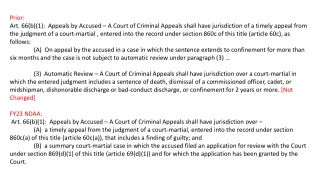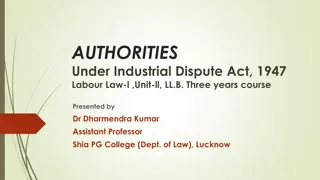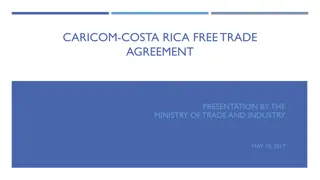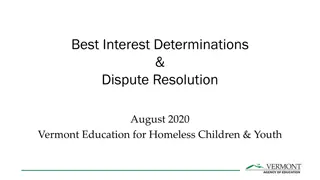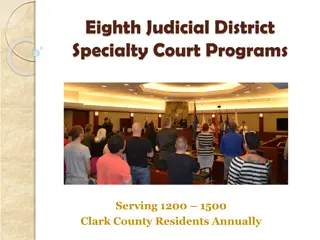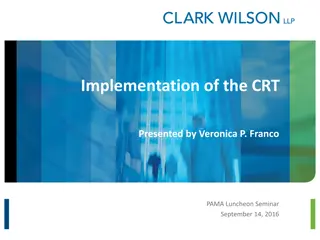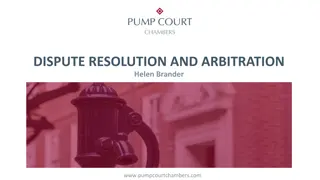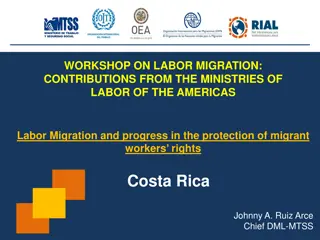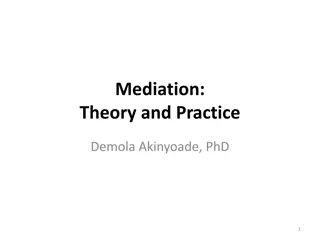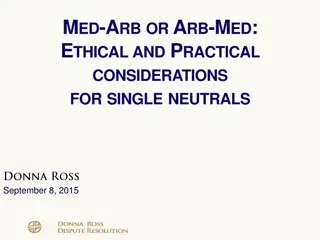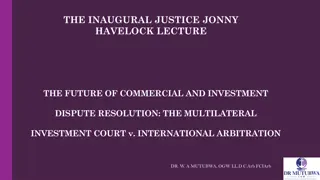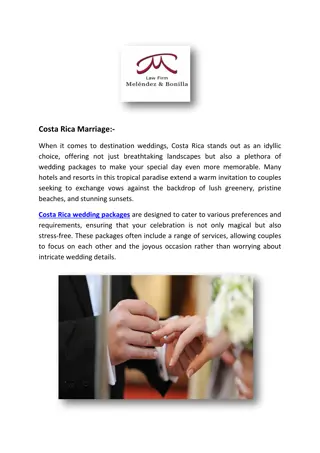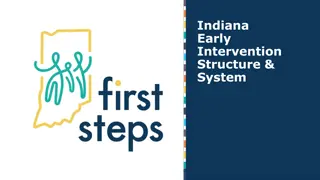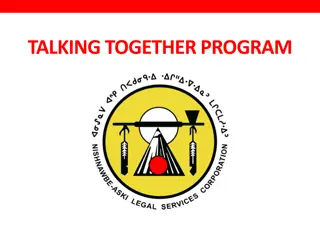
Recent Changes to Family Procedure Rules for Non-Court Dispute Resolution
Explore the significant recent changes in the Family Procedure Rules aimed at promoting Non-Court Dispute Resolution (NCDR), including mandatory forms, gatekeeping procedures, and the expanded definition of NCDR to include mediation, arbitration, collaborative law, and early neutral evaluation.
Download Presentation

Please find below an Image/Link to download the presentation.
The content on the website is provided AS IS for your information and personal use only. It may not be sold, licensed, or shared on other websites without obtaining consent from the author. If you encounter any issues during the download, it is possible that the publisher has removed the file from their server.
You are allowed to download the files provided on this website for personal or commercial use, subject to the condition that they are used lawfully. All files are the property of their respective owners.
The content on the website is provided AS IS for your information and personal use only. It may not be sold, licensed, or shared on other websites without obtaining consent from the author.
E N D
Presentation Transcript
Non Court Dispute Resolution (NCDR) Elissa Da Costa-Waldman e
Why are there changes to the Family Procedure Rules (FPR) regarding NCDR? The court system was broken before Covid, Covid made things worse .. The President of the Family Division has made it clear that the workload of the family courts is unsustainable Private Law Children Proceedings and Financial Remedy Applications are considered appropriate for NCDR If the changes do not reduce the workload of the courts, it may be that mandatory NCDR will be brought in Changes aim to increase MIAM attendance and encourage earlier resolution of private law disputes
What are the recent key changes to the Family Procedure Rules (FPR)? Form FM5 (statement of position on Non Court Dispute Resolution) MUST be completed in private law children proceedings in which the MIAM requirement applies and in contested financial remedy proceedings and, except in cases where domestic abuse is in issue, parties will be required to file and serve a standard form setting out their views on engaging with NCDR the form must be filed and served seven days before the first on notice hearing and, if the court so directs, before any subsequent hearing in the proceedings
What are the recent key changes to the Family Procedure Rules (FPR)? Gatekeeping if applicant claims a MIAM exemption, court will issue proceedings BUT will enquire into the exemption claimed In private law proceedings, such enquiry is made at the stage the case is allocated to a level of judge (children cases) and in financial remedy applications at the stage at which the case is allocated, if appropriate, or at the first hearing The court may review- any supporting evidence to ensure MIAM exemption validly claimed Or whether exemption still applicable; and If not validly claimed or no longer applicable, court may direct parties to attend a MIAM and adjourn for that purpose
What are the recent key changes to the Family Procedure Rules (FPR)? NCDR defined previously only referred to mediation definition is widened to include:- Arbitration Collaborative Law Early Neutral Evaluation (e.g. pFDRs) MIAM mediator must therefore explore all forms of NCDR with the parties as to which might be most suitable in resolving their dispute, not just the suitability of mediation
What are the recent key changes to the Family Procedure Rules (FPR)? Domestic Abuse redefined Domestic Violence is amended to Domestic Abuse (see meaning given in ss 1 and 2 Domestic Abuse Act 2021 Previous requirement that person with whom a prospective party is or was in a family relationship is amended to a requirement for the parties to be personally connected.
What are the recent key changes to the Family Procedure Rules (FPR)? Exemptions Mediator s Exemption is removed If the mediator contacts a prospective respondent and determines they are unwilling to attend a MIAM, the prospective applicant should still attend one Previous NCDR If within 4 months prior to the date of the court application, the prospective applicant has attended NCDR in relation to the same, or substantially the same, dispute to which the court proceedings relate, a MIAM exemption applies BUT the applicant MUST provide evidence of that attendance, i.e. written confirmation from the NCDR provider that they have attended
What are the recent key changes to the Family Procedure Rules (FPR)? Case management Contrast with CPR where court has power to require parties to attend NCDR FPR Court has a duty to consider, at each stage of proceedings, whether NCDR is appropriate Where gaps in time between hearings which court considers parties should utilise to attend NCDR, court should make this clear to the parties AND court has general powers to adjourn proceedings , using its discretion to determine the length of time for any adjournment to enable NCDR to take place.
What are the recent key changes to the Family Procedure Rules (FPR)? Costs If court allows time for NCDR or adjourns proceedings specifically for that purpose, ANY FAILURE OF A PARTY to attend NCDR will not affect the substantive decision BUT the court may take into account such conduct in failing to attend NCDR when considering whether to make a costs order. FPR Rule 28.3(7) is amended with respect to financial proceedings to add provision for the court to have regard to any failure by a party without good reason to attend a MIAM or attend NCDR
What are the recent key changes to the Family Procedure Rules (FPR)? MIAM attendance This has been expanded to allow attendance online or by video-link The prospective applicant must contact as many authorised family mediators as have an office within 15 miles of their home (or 5 of them if there are 5 or more) Where all of them state they are not available within 15 business days of the date of contact an exemption may be claimed, and The applicant will need to evidence with their application names, contact information and details of dates of contact with the family mediators if claiming an exemption
Pre-Action Protocols Ethos is that court is the last resort for resolving disputes PD 9A provides a Pre-Action Protocol for Financial Remedy Applications PD 12B provides a Pre-Action Protocol for Private Law Children Proceedings
Law Society Family Law Protocol Law Society Family Law Protocol Family Lawyers are REQUIRED to explain Family Lawyers are REQUIRED to explain to clients alternative methods of to clients alternative methods of resolving disputes outside the court resolving disputes outside the court process process
Clients should be informed about ALL forms of NCDR Different methods of NCDR should be kept under review throughout a case Clients should also be informed that methods of NDCR may be used in combination and are not mutually exclusive E.g.: Arb/Med or Med/Arb
Case Law since NCDR changes X v Y [2024] EWHC 538 Knowles J Financial Remedies case decided in March 2024 just before rule changes.
The Facts: Following the end of their 15-year marriage the husband and the wife were engaged in both children and financial remedy proceedings. The asset base was 27m 29m and the financial case proceeded on the basis of a needs claim by the wife. No settlement was reached at the FDR and the final hearing was listed for June 2024. At the pre-hearing review in January 2024, the parties recognised that it was desirable to try to resolve their financial dispute by means of non-court dispute resolution prior to the final hearing: there was time to do so without adjourning the hearing.
Gwynneth Knowles J gave a short ruling on non-court dispute resolution for the guidance of those involved in family proceedings, whether concerning money or children. [2] This short ruling is being given today not because the parties are opposed to the course I have invited them to take but because I consider it might be helpful for those involved in family proceedings, whether concerning money or children, to understand the court's expectation that a serious effort must be made to resolve their differences before they issue court proceedings and, thereafter, at any stage of the proceedings where this might be appropriate. Furthermore, I want to signal that, at all stages of the proceedings, the court will be active in considering whether non-court dispute resolution is suitable. Changes to the Family Procedure Rules 2010 ('the FPR') which are due to come into effect on 29 April 2024 will give an added impetus to the court's duty in this regard.
[7] Rule 3.3.(1) of the FPR mandates the court with a duty to consider if non-court dispute resolution is appropriate at every stage in proceedings (my emphasis). When considering whether non-court dispute resolution is appropriate, r 3.3.(2) states that the court must take into account whether (a) a MIAM (a family mediation information and assessment meeting) took place; (b) whether a valid MIAM exemption was claimed or mediator's exemption was confirmed; and (c) whether the parties attempted mediation or another form of non-court dispute resolution and the outcome of that process. Rule 3.4.1(a) states that, where appropriate, the court may direct that proceedings or a hearing in the proceedings be adjourned for a specified period in order to enable the parties to obtain information and advice about, and consider using, non-court dispute resolution. r 3.4(1)(b) states that adjournment for a specified period may also be appropriate where the parties agree to participate in non-court dispute resolution. The court may make such directions on application of the parties or of its own initiative.
[8] All the above rules are to be read in the context of the court's overriding objective to deal with cases justly having regard to any welfare issues (r 1.1(1). Rule 1.1(2) states that dealing with a case justly includes, as far as practicable, the saving of expense and the allocation of an appropriate share of the court's resources. The court also has a duty of active case management (r 1.4(1)), amongst which is encouraging parties to use a non-court dispute resolution procedure if the court considers that appropriate and facilitating the use of such procedure (r 1.4(2)(f)), and helping the parties to settle the whole or part of the case (r 1.4(2)(g)).
[9] The FPR does not, at present, give the court power to require parties to engage in non-court dispute resolution. Rule changes on 29 April 2024 will promote the court's ability to encourage parties in financial remedy and children proceedings to use natural gaps in the parties in financial remedy and children proceedings to use natural gaps in the proceedings' timetable proceedings' timetable for the purpose of non-court dispute resolution or to adjourn the proceedings, if necessary, to encourage the parties to try non-court dispute resolution. encourage Amendments to the costs sanctions the court can impose in financial remedy proceedings will take into account conduct relating to a failure either to attend a MIAM or to attend non-court dispute resolution.
KFK v- DQD [2024] EWFC 78 (B) The Facts Around a 9-year relationship (dispute about exact length) Second marriage both parties Each had a child from their previous relationship H 56, W 44 Equity in London property 552,000 Each side alleged the other had significant wealth in China (Recorder did not accept either party s account) W had an illiquid interest in a property which was tied to her mother s home H had business assets but were treated as income producing and not capital
64/36% apportionment of assets in Hs favour on clean break basis sounds harsh but reasoning is below- 251. If the net proceeds of [Flatacre] are divided 64/36 in the husband's favour (with the proceeds being top-sliced to clear the joint service charge arrears), then each party will have enough to rehouse modestly. 252. The parties' needs are for a one-bedroomed flat which can be met on the basis of the particulars I have seen between 400,000 and 500,000. I am going to say needs can be met in the parish of 450,000, but clearly choices can be made under or over that mark. 253. The husband will be able to combine his 370,147 (for which see table below) with a mortgage capacity, his relative youth and whatever support he gets from his parents which I have found he will have. That will meet his needs.
254. He is cohabiting somewhere at the moment, although as I have stated above, I am unaware of the terms of that occupation. He does have a roof over his head in any event. The husband may have to remain where he is, or rent for a bit until he is able to develop and deploy his mortgage capacity as I have found it to be. He may have to reduce his international travel and trips to high- end stores. However, I am satisfied with a bit of application he will be fine, and his housing and income needs will be met. 255. The wife will be able to rehouse at 450,000, but of necessity without mortgage or family support, beyond the return of money which I have found is beneficially owned by her and which I find will be returned to her. Subject to the size of flat she chooses to purchase, she may retain a small capital sum which will help meet her living costs for the time being. My departure from mathematical equality is driven by the needs as I perceive them in this case.
KFK v- DQD [2024] EWFC 78 (B) Commentary This was yet another case where the assets are modest, but the parties wanted to sling as much mud as they can at each other! There were issues of the whether documents were fraudulent, soft loans, hidden assets and non-disclosure, chattels . Recorder Taylor took a proportionate approach (see Peel J s comments earlier). With regard to chattels, the Recorder gave the parties the usual option of resolving those matter themselves within a time limit but reserved the option of all disputed items being sold on eBay or something similar! Total costs were over one third of the net liquid assets in the case! No costs order made. Comment on how sorrow and cost could have been avoided if parties had considered NCDR.
HOW WILL THE CHANGES AFFECT OUR PRACTICES? Positively because clients will see the benefits of having a degree of autonomy over the outcome (and perhaps less stress for us!) Research demonstrates the effects of relationship dis-ease and breakdown on children. Better for them to have parents who can agree Grandparents can also become excluded, often unintentionally, from the lives of their grandchildren at a time when their presence and assistance could ease everyone through a difficult period. Agreements can cover this aspect of the newfamily setup
The parties going through relationship breakdown often become depressed, angry, upset and frightened about the future. Communication is difficult if not impossible. NCDR is a way to begin communicating again in a safe environment not only to negotiate outcomes but for signposting to other agencies to help with particular needs or issues
There are many pieces of equipment in the lawyers toolbox Using the right tools or a combination can assist parties in avoiding court and retaining civilised and dignified relationships in reconfigured families well into the future What tools do we have?
Types of Non-Court Dispute Resolution Negotiation Round Table Meetings Mediation what type? Collaborative Law Early Neutral Evaluation (ENE) pFDRs Arbitration
Negotiation Pros and Cons Savings in costs as disputes may be resolved more quickly and efficiently Less stress and emotional pressure for the Clients Certainty rather than the gamble of a court hearing Flexibility the ability to provide by way of indemnity and/or undertakings for matters which the court has no jurisdiction to order All encompassing Reduced acrimony between the parties Comprehensiveness time to ensure that all issues are dealt with.
Negotiation Pros and Cons Method? Correspondence often becomes argumentative and adversarial! Phone call always good to talk with opposite number Zoom we used it in Covid, great to use now Face to face call an opponent and have a coffee
Round Table Meetings Pros and Cons Works well with cooperative parties Have an agreed agenda circulated prior to RTM Check who is attending No non-parties Lawyers and clients only Fails if- too many agenda items Unstructured Too long!
Mediation Pros and Cons Reduces tension and hostility Solutions are tailor made to the Clients needs Decisions are made on an informed basis (lawyers can be present) Clients are able to communicate and co-operate (can always do shuttle mediation in cases of DA) Clients are able to explore and examine options in a safe environment Clients are able to appreciate and consider the needs of their children Savings in costs as disputes may be resolved more quickly and efficiently
Mediation Pros and Cons What type of mediation best suits your clients/the case? Resolution style (lots of smaller meetings over a period of time) works well for FR cases Commercial style (trial ready one day, often counsel present) works well in TOLATA cases
Collaborative Law Pros and Cons Everyone enters the process in good faith so it can be quicker and less acrimonious If things become difficult the Clients can be reminded of their obligations as stated in the Participation Agreement and their anchor statements Clients set their own agenda Clients move along the process at their own pace There is full and frank disclosure so decisions are reached from a position of knowledge Collaborative process helps to keep the channels of communication open
Collaborative Law Pros and Cons It s USP is often what puts potential clients off Can be expensive with two way meetings between lawyer and clients, between lawyers and the four way meetings between clients and their lawyers
Early Neutral Evaluation Pros and Cons ENE is the civil version of a Financial Dispute Resolution Appointment Each Client is provided with a view of their likelihood of success in court Each Client is able to assess their respective position and decide whether it is more cost/benefits efficient to litigate Clients have the opportunity to evaluate whether a mediation or continuing mediation could be workable Disputes can be assessed on paper rather than an attendance
Early Neutral Evaluation Pros and Cons A paper hearing could be helpful in those cases where Clients find it difficult to face each other and prefer not to be in the same room together An indication can often scupper further negotiations if one side s offer is far more preferable than the other difficult to pull back from that! Parties have to be engaged and willing to settle not merely pay lip service to the process
Private FDRs Pros and Cons The private FDR can take place anywhere at any time convenient to the parties, their legal representatives and the FDR judge in a court-based FDR, the judge is appointed by the court system, in a pFDR parties can choose and agree their pFDR judge The parties in consultation with the private FDR judge are free to agree their procedure
Private FDRs Pros and Cons The process can be more cost-effective. A significant difference between a court-based FDR and a pFDR is that the pFDR judge will need to be paid by the parties. However, choosing this tailor-made route may ultimately be more cost-effective is resolving the case and achieving an early settlement. An indication of likely outcomes from an experienced FDR judge at an early stage can help achieve an earlier settlement thus reducing the costs involved
Private FDRs Pros and Cons Unlike the court-based FDR, the pFDR judge is available to hear and deal with one case over the course of the entire day so can has the time to be able to provide much more assistance to facilitate a settlement being reached. Neither party is bound by the indication given unless they choose to agree the settlement
Private FDRs Pros and Cons If settlement is not achieved, the pFDR judge can assist to narrow the issues between the parties. Unlike the court-based FDR, parties do not have to be engaged in proceedings and are available as part of a voluntary process of trying to achieve settlement
How does one choose a pFDR Judge? Choice of pFDR judge will depend on knowledge, experience, expertise and cost Enquire of Chambers you use regularly as they will probably have a NCDR team Look at IFLA website as all qualified family arbitrators will be capable of conducting a pFDR Financial Remedies Journal website has a directory of pFDR judges
Arbitration Pros and Cons Clients select their decision maker from a panel of qualified Family Law Arbitrators Arbitrator is continuously and directly involved once appointed Confidentiality,adaptability adjudication process The process avoids delays and standardisation resulting in speed and costs savings compared with conventional litigation route and flexibility within the
Arbitration Pros and Cons Versatility in covering all levels of financial dispute as well as resolving discrete issues in a case (also available in Children Cases) Suitable for those who cannot agree or have already reached impasse using other dispute resolution methods Finality and enforceability similar to that which is available through litigation Only downside is potentially more expensive but if timing is important, speed may lessen costs in the long term
Q & A You are invited to ask away in an indemnity free zone!!
Non Court Dispute Resolution (NCDR) Elissa Da Costa-Waldman

